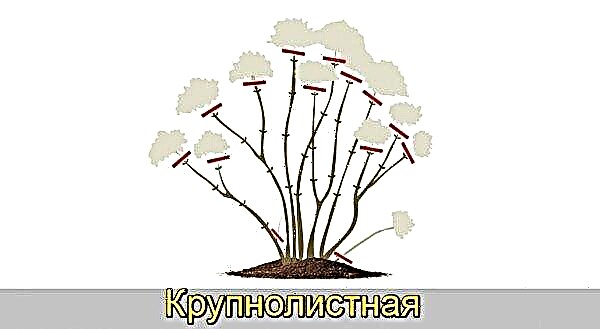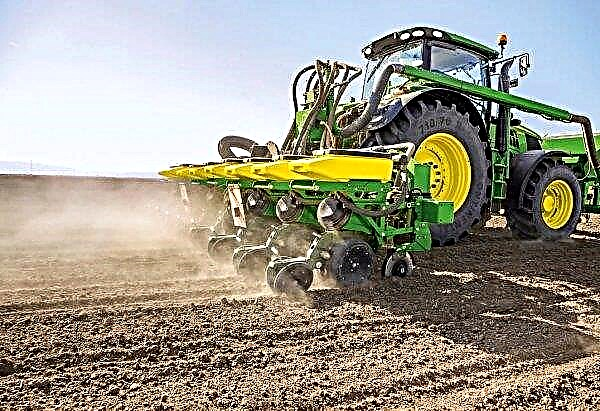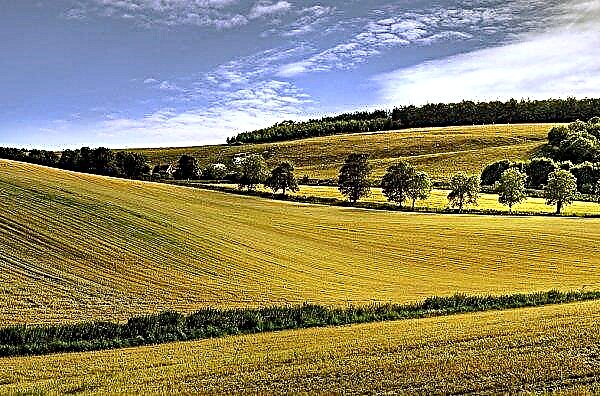The hive is an artificial house built by man for keeping honey bees. It depends on its design how strong and able-bodied the bee family will be. In addition, the hive should be convenient to clean. In this regard, the buildings of Dadan, which you can assemble yourself, are very popular. The manufacturing technology of such hives is described below.
Characteristics and history of the Dadan hive
Charles Dadant is a French beekeeper who immigrated to America in 1863, where he soon became the largest producer of honey. He was always fascinated by bees, so his main task in life was to try to find the best way to keep and breed them.
Did you know? The inhabitants of one hive have their own unique smell, by which the guards of the bee house determine whether it is their own or someone else's. Upon returning home, each bee must “present” its aroma to the guard. If he is a stranger, then they will not let her pass.
In the course of his many experiments and calculations, he found that a young queen bee is able to lay about 3,000 eggs per day. In addition, he found out that in a day, bees are able to fill honeycombs with 1600 cells. Based on these data, he realized that the optimal number of frames in the hive is 12; then the total number of cells will be 10500. Based on these calculations, Charles created a new construction of the hive, which was the most optimal.

In his work, he used the achievements of other inventors, but his work was taken as a basis: the Swiss Blatt decided to optimize Charles's development and make it more suitable for European bees. Now standard nesting sizes: 435 × 300 mm instead of 470 × 300 mm. Store frames have dimensions of 435 × 145 mm. Often such a beehive, Dadana-Blatt, is made without baltz, while Dadanovskiy is made with fold.
The Dadanov hive is a single or double hull structure in which 10, 12, 14 frames can be installed. The supporting part of the structure is in the form of a cube with a fixed bottom. The roof is simple, and the rest of the structure is just as simple. In general, the hive of this design is very convenient to use. In the single-hull version, it can be easily transported for any number of frames, it is convenient to control the state of the family and prevent swarming in time, it is easy to prepare the bee house for wintering and resettle it for a weaker family, strong or vice versa.
Advantages and disadvantages of the hive
- The advantages of this type of product include:
- the ability to breed families vertically, which is more natural than horizontal;
- when using a two-hull structure, there is a lot of free space for the development of the family, which avoids swarming;
- the design of the hive is such that it is easy to pump honey from it from any level of the structure;
- dividing the frames into magazine and nesting allows to increase the service life of the latter;
- from diseases and pests, bees are processed only in the nesting part, which allows avoiding the ingress of harmful substances into the combs of the store part of the hive;
- honey is obtained from store frames of higher quality than from nesting ones, and is less prone to crystallization;
- The store extension is lightweight, which allows you to install it alone.
- The disadvantages include:
- due to the level design, it is impossible to often inspect the nesting framework, which complicates the determination of the moment of swarming of the family;
- since bees lay honey in half-frames, and winter in nesting combs, it is necessary to take care of feeding in the autumn-winter period;
- the assembled construction is bulky, which complicates the transportation, if you need to urgently change the location.
How to make a Dadan hive with your own hands
Making a Dadanov house for bees on your own is not a big deal. The main thing is to calculate everything correctly and follow the manufacturing recommendations.
Size calculation
When creating a drawing, it must be taken into account that the finished construction has a front shield thickness of 40 mm at a height of 320 mm and a width of 530 mm. The rear shield has similar dimensions. Side panels have a width and height of 480 mm and 320 mm, respectively. Their thickness is the same as that of the front and rear. The internal dimensions of the structure are 450 × 450 × 320 mm. Hive parts are assembled through folds.
10-frame design:
12-frame design:
General view of the structure:
Necessary tools and materials
For work you will need:
- joiner's board (50 mm thick from dry wood);
- plywood;
- woodworking Machine;
- hammer;
- clamp;
- nails
- paint;
- high-quality glue for wooden products.
How much lumber is needed depends on the dimensions of the selected product.
Build Features
The assembly of the structure must be carried out in stages.
Score
From the board you need to cut the bars with a thickness of 35 mm. The length of the beam should correspond to the length of the wall plus 25 mm of the margin. After the workpiece is glued to obtain the desired dimensions. There should be two faces of 470 mm and two faces of 445 mm in length, their height is 330 mm. These are nesting dimensions; Store height should be 2 times less. The described nesting is ten-frame.

Folds
To properly assemble the structure, it is necessary to make folds on the smaller rectangles. According to GOST, the fold size is 20 × 11 mm, but quarters are usually selected in width, corresponding to the thickness of the docking part. In this embodiment, on a smaller part from the inside from the side edges, you need to retreat 35 mm. The fold depth will be 15 mm.
For installation of frames folds are carried out in accordance with GOST. They need to be selected in a circle on the inside of the structure. In order for the store to fit snugly against the case, a fold of 10 × 14 mm is made in the upper part of the nesting place.
The following options are provided for add-ons:
- lower inner part along the front and rear wall (28 × 10 mm);
- lower inner part along the side walls (18 × 10 mm);
- upper outer part along the front and rear wall (4 × 10 mm);
- upper outer part along the side walls (14 × 10 mm).
Diaphragm
The diaphragm is a separation board in the nesting area. It should be two pieces. For her, a frame is assembled from boards the width of the inside of the hive and the height is slightly less than the height of the nest. A plywood sheet is attached to the frame.

Housing
The case is assembled like the previously described store.
Important! The internal dimensions of the 10 and 12-frame hives are the same. Typically, 12-frames are made and, if necessary, two frames are removed. For a larger number of frames to carry out the design is less appropriate.
Dimensions of 10-frame construction:
- front and rear shield (530 × 320 × 40 mm);
- side shields (490 × 320 × 40 mm);
- 380 mm thick bottom.
In cold regions, structures with 14 frames are used. Such products are most often performed double-walled, as they require additional insulation. Double is the bottom, having a lining. The internal width of the hive, due to the addition of two frames, increases by 75 mm and equals 510 mm. Since the design is dimensional, it is often used without add-ons.

Bottom
The bottom is a visor that can be removable or fixed. In front of the hive, it protrudes by 35 mm. Here is attached the arrival board. The shield is made of boards with dimensions: 54 × 48 × 3.5 cm (L × W × T).
Arrangement of letoks
When marking the walls of the hive, you need to take into account that the front wall should be 15 mm shorter than the rest. This gap is a tap hole; it is desirable to equip the valve. Above it is a sleeve. It is used during the cleaning of the bee house in the spring, and to enhance ventilation.
Upper notch (25 mm) - a hole drilled at a height of 7 cm from the upper edge of the housing. In superstructures, a notch is cut in the center of the front wall. The diameter is the same.
Ceiling
The ceiling is made of boards: 478 × 80 × 10 mm (L × W × T). They are stacked in folds made on the front and rear walls. To keep the nest warmer in the winter, a roof cover is made in the form of an extension. Ceiling boards are installed inside the structure, and the remaining space is filled with insulation.

Dimensions of the armpit:
- 53.5 cm - front and rear walls, length;
- 50.5 cm - sidewalls, length;
- 9 cm - width;
- 1.5 cm - thickness.
Roof
The removable roof can be made in different versions: gable, single gable, flat. It is made from boards.
Roof Dimensions:
- 105 mm - tying height;
- 535 mm - sidewalls, length;
- 535 mm - end part, length;
- 15 mm - thickness.
Important! In the end part, it is necessary to make a ventilation hole protected by a fine metal mesh.
Features of keeping bees in Dadan hive
When keeping bees in the Dadanov hives, it must be taken into account that during the period of a plentiful bribe, they quickly fill the honeycomb with nectar, which is why egg laying is limited. This can lead to weakening of the family, so you need to set up a store in a timely manner.
The principle of keeping bees in such a house is simple: insects wintering takes place in a single building, feeding is carried out at the end of winter. In the spring, after checking the hive, frames with wax are added to it. When the family gets stronger after winter, stores can be delivered. Their replacement is carried out as filling.

Such a house settles simply:
- Near it is a similar design, but empty. 4-5 frames with brood are transferred into it.
- There should be several open and several closed brood frames. The first is taken first.
- When moving the frames, you need to ensure that the uterus remains in the old hive.
- Several frames with honey are added to the brood frames, placing them along the edges.
- After that, you can continue to work with the old bee house. Empty frames with a wax are added to it in place of those seized - so that they are mixed with full ones.
- The frame with the uterus should be the most extreme, relative to the honey frames.
- After the wax has been added, lay the separation grid on the housing and a second one is placed on top of it.
- After 5-6 days you need to check the condition of the second building.
- In a week, it will be possible in the second building to add the missing number of frames to a complete set.
Did you know? The modern frame design of the hive was developed in 1851 in the States by L. Langstrotom.
So, the construction of the Dadan hive is simple and effective. You can easily assemble it yourself, but only if the correct calculation of the dimensions of the product is made.












